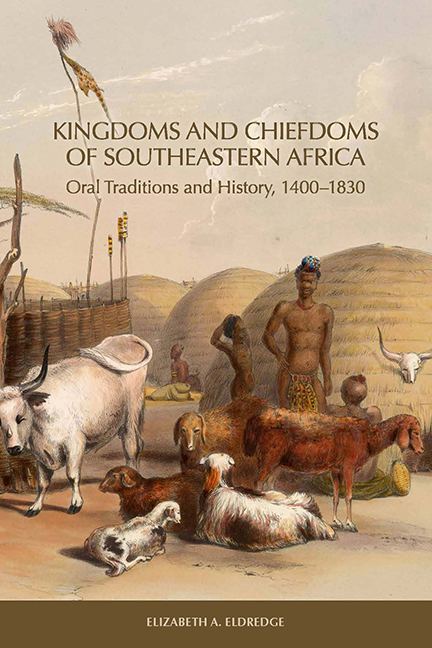Book contents
- Frontmatter
- Contents
- List of Illustrations
- Preface
- 1 History and Oral Traditions in Southeastern Africa
- 2 Oral Traditions in the Reconstruction of Southern African History
- 3 Shipwreck Survivor Accounts from the Sixteenth and Seventeenth Centuries
- 4 Founding Families and Chiefdoms East of the Drakensberg
- 5 Maputo Bay Peoples and Chiefdoms before 1740
- 6 Maputo Bay, 1740–1820
- 7 Eastern Chiefdoms of Southern Africa, 1740–1815
- 8 Zulu Conquests and the Consolidation of Power, 1815–21
- 9 Military Campaigns, Migrations, and Political Reconfiguration
- 10 Ancestors, Descent Lines, and Chiefdoms West of the Drakensberg before 1820
- 11 The Caledon River Valley and the BaSotho of Moshoeshoe, 1821–33
- 12 The Expansion of the European Presence at Maputo Bay, 1821–33
- 13 Southern African Kingdoms on the Eve of Colonization
- Appendix A Ama Swazi King Lists
- Appendix B Chronology of Conflicts, Migrations, and Political Reconfiguration East of the Drakensberg in the Era of Shaka
- Appendix C Interviewees from the James Stuart Collection of Oral Traditions
- Notes
- Bibliography
- Index
- Frontmatter
- Contents
- List of Illustrations
- Preface
- 1 History and Oral Traditions in Southeastern Africa
- 2 Oral Traditions in the Reconstruction of Southern African History
- 3 Shipwreck Survivor Accounts from the Sixteenth and Seventeenth Centuries
- 4 Founding Families and Chiefdoms East of the Drakensberg
- 5 Maputo Bay Peoples and Chiefdoms before 1740
- 6 Maputo Bay, 1740–1820
- 7 Eastern Chiefdoms of Southern Africa, 1740–1815
- 8 Zulu Conquests and the Consolidation of Power, 1815–21
- 9 Military Campaigns, Migrations, and Political Reconfiguration
- 10 Ancestors, Descent Lines, and Chiefdoms West of the Drakensberg before 1820
- 11 The Caledon River Valley and the BaSotho of Moshoeshoe, 1821–33
- 12 The Expansion of the European Presence at Maputo Bay, 1821–33
- 13 Southern African Kingdoms on the Eve of Colonization
- Appendix A Ama Swazi King Lists
- Appendix B Chronology of Conflicts, Migrations, and Political Reconfiguration East of the Drakensberg in the Era of Shaka
- Appendix C Interviewees from the James Stuart Collection of Oral Traditions
- Notes
- Bibliography
- Index
Summary
When I first arrived in Lesotho in March 1981, it was listed as one of the ten poorest countries in the world. The strains of apartheid and resistance in South Africa and the Cold War in neighboring countries had taken its toll and continued to do so across the region for the next decade. I had the pleasure of visiting Swaziland, South Africa, and Botswana in 1981 and lived in Lesotho for eighteen months until September 1982. I was able to return on short research trips to Lesotho more than once, but I did not return to the other countries in the region until 1992. On that visit I attended a conference at the then University of Durban-Westville and visited several universities in South Africa that were grappling with the political changes finally coming in their country. Only by requesting business visas was I able to travel for the first time with my family, including my four-year-old and eight-year-old children (who also received business visas), to Mozambique, where war was still felt on the outskirts of Maputo, and the political problems there were yet to be resolved. The streets were full of homeless children, and British soldiers had assisted in securing some areas before UNIMOZ arrived to secure a transition to peace. People were surprised and pleased to see visiting American youngsters, and the prospect for the research I had long since planned to do began to seem feasible. Over the course of the years it had become obvious that language barriers had handicapped the work of scholars in the field of southern African history, and few people were able to work not only in English but also in Portuguese (which I studied at night school at the University of Pittsburgh while I was writing my dissertation) and in the southern Bantu languages, of which I had studied IsiXhosa, SeSotho, and IsiZulu under the auspices of Professor Wandile Kuse, then at the University of Illinois, and Professor Daniel Kunene at the University of Wisconsin–Madison. With the ability to read and converse in these languages, I had an unusual qualification to conduct cross-border research that would provide new insights and depth into the precolonial history of southeastern Africa, when colonial borders were neither present nor relevant. The present book is the result.
- Type
- Chapter
- Information
- Kingdoms and Chiefdoms of Southeastern AfricaOral Traditions and History, 1400–1830, pp. ix - xiiPublisher: Boydell & BrewerPrint publication year: 2015

